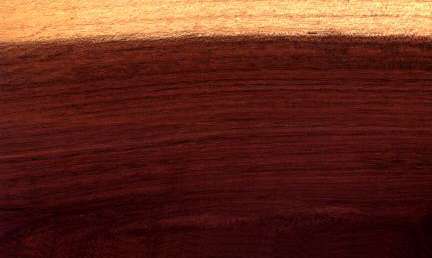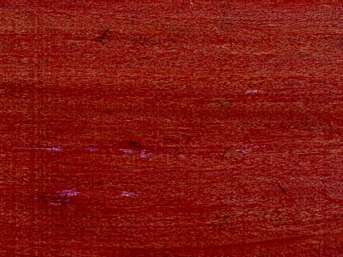 
Purpleheart (Peltogyne venosa)
Family: Leguminosae
Common names: Amarante, Amaranth, Amaratante, Barabu, Bois pourpre, Bois voilet, Daba, Dastan, Ellongrypho, Guaraburajado, Guarabroboreli, Koroborezi, Kuruburelli, Lastan, Malako, Maraka, Mor ado, Morado, Nazareno, Palo morado, Pau roxo, Pau violeta, Pelo morado, Purperhart, Purpleheart, Saka, Sakavalli, Sapater, Tananeo, Violet, Violet wood, Violetwood, Zapatero
Distributed in: Brazil, Chile, Colombia, Costa Rica, French Guiana, Guyana, Haiti, Honduras, Mexico, Panama, Peru, Suriname, Trinidad and Tobago, Venezuela (Central America, Latin America, Oceania and S.E. Asia)
Distribution overview: Timber produced by about 20 species including, P. venosa , which grow in Central America and tropical South America, from Mexico to southern Brazil are collectively referred to by the trade name Purpleheart. They are most common in the Amazon basin, and are also found in Colombia, Guyana, Surinam, and Venezuela.
Common uses: Agricultural implements, Bedroom suites, Billiard-cue butts, Boat building (general), Boat building: decking, Boat building: framing, Boat building: planking, Bobbins, Bridge beams, Bridge construction, Bridge joists, Building construction, Building materials, Cabin construction, Cabinetmaking, Canoes, Carvings, Chairs, Chemical containers, Chests, Concealed parts (Furniture), Construction, Decorative veneer, Desks, Dining-room furniture, Docks, Dockwork, Domestic flooring, Dowell pins, Dowells, Drawer sides, Factory construction, Figured veneer, Filter press plates, Fine furniture, Floor lamps, Flooring, Furniture , Furniture components, Furniture squares or stock, Furniture, Handles, Handles: general, Hatracks, Heavy construction, Joinery (external): ground contact, Joinery, Kitchen cabinets, Light construction, Living-room suites, Marine construction, Marquetry, Mathematical instruments, Millwork, Mine timbers, Moldings, Office furniture, Paneling, Piling, Railroad ties, Shade rollers, Skis, Sporting Goods, Tables, Tool handles, Turnery, Vats, Vehicle parts, Walking sticks, Wheel spokes
Product sources: The ITTO reports that timber production from this species is regular. The material is exported at a low but regular rate. Supplies are ample, but the wood is fairly expensive. It costs more than mahogany but less than teak. Although it has not found wide demand, Purpleheart is available on the US market in both the lumber and veneer forms.
Environment profile: Vulnerable
Tree size: Trunk diameter is 150-200 cm
Colors: the heart isPurple, Redand the sapwoodWhite to yellow, Yellow.The grain isWavy, the textureMediumand the lusterSlightly lustrous
Natural durability: Very durable, Very resistant to dry-wood termite attack
Odor: No specific smell or taste
Kiln Schedules: UK=E US=T6D2/T3D1 Fr=5
Kiln Drying Rate: Naturally dries slowly
Drying Defects: Slight surface checking, Slight twist/warp
Ease of Drying: Variable results.
Tree Identification: Bole/stem form is straight
Comments: General finishing qualities are rated as good Treatment against ultra-violet fading has been suggested since the wood turns gray-brown upon exposure to sunlight. A treatment with Armorall, the car finish product, under lacquer is reported to maintain the original color wellWorking the wood with dull cutting tools may cause gum exudation
Blunting Effect: Blunting is rated as moderate to severe
Boring: Fairly easy to very easy
Carving: Fairly Easy to Very Easy
Cutting Resistance: Moderate to fairly difficult to saw
Gluing: Easy to glue
Mortising: Fairly Easy to Very Easy
Moulding: Fairly Easy to Very Easy
Movement in Service: Fairly Easy to Very Easy
Nailing: Pre-boring recommended, Very Good to Excellent
Planing: Respond poorly to ordinary tools
Resistance to Impregnation: Sapwood is permeable
Resistance to Splitting: Poor
Response to hand tools: Response to hand tools is fair
Routing recessing: Fairly Easy to Very Easy
Sanding: Good sanding finish
Veneering qualities: No steaming needed during bolt preparation., Suitable for slicing
Steam bending: Fairly well defined
Turning: Good results
Polishing: Surface Preparation; Staining: Takes finishes rather well ;
- Numerical data Metric
- Numerical data English
- Strength properties
- References
 |
 |
 |
 |
| Item |
Green |
Dry |
Metric |
| Specific Gravity |
0,63 |
0,69 |
|
| Density |
|
849 |
kg/m3 |
| Bending Strength |
1038 |
1501 |
kg/cm2 |
| Crushing Strength |
105 |
163 |
kg/cm2 |
| Hardness |
|
919 |
kg |
| Impact Strength |
|
|
cm |
| Shearing Strength |
|
157 |
kg/cm2 |
| Stiffness |
150 |
172 |
1000 kg/cm2 |
| Tangential Shrinkage |
6 |
|
% |
| Radial Shrinkage |
3 |
|
% |
| Weight |
865 |
689 |
kg/m3 |
| Maximum Load |
0,84 |
1,12 |
cm-kg/cm3 |
| Toughness |
|
253 |
cm-kg |
| Static Bending |
644 |
879 |
kg/cm2 |
|
 |  |  |  | | Item | Green | Dry | English | | Bending Strength | 14776 | 21353 | psi | | Crushing Strength | 1499 | 2327. | psi | | Density | | 53 | lbs/ft3 | | Hardness | | 2028 | lbs | | Maximum Crushing Strength | 7563 | 10853 | psi | | Shearing Strength | | 2235 | psi | | Static Bending | 9173 | 12515 | psi | | Stiffness | 2147 | 2460 | 1000 psi | | Toughness | | 220 | inch-lbs | | Work to Maximum Load | 12 | 16 | inch-lbs/in3 | | Specific Gravity | 0.63 | 0.69 | | | Weight | 54 | 43 | lbs/ft3 | | Radial Shrinkage | 3 | | % | | Tangential Shrinkage | 6 | | % | | Volumetric Shrinkage | 10 | | % | |
Density (dry weight) = 53-60 lbs/cu. ft
Bending strength (MOR) = high
Shearing strength (parallel to grain) = medium
Modulus of Elasticity (stiffness) = high
Max. crushing strength = high
Max. crushing strength = very high
Hardness (side grain) = hard
Bending strength (MOR) = very high
Shrinkage, Tangential = moderate
Shrinkage, Tangential = fairly large
Shrinkage, Radial = small
Max. crushing strength = medium
Density (dry weight) = 61-67 lbs/cu. ft
Density (dry weight) = 46-52 lbs/cu. ft.
Weight = very heavy
Shrinkage, Tangential = small
Shrinkage, Radial = very small
Shrinkage, Radial = large
Shrinkage, Radial = fairly large
Modulus of Elasticity (stiffness) = very high
Hardness (side grain) = medium
Density = very high
Bending strength in the air-dry condition (about 12 percent moisture content) is very high
Bending strength (MOR) = medium
It is hard, and quite resistant to denting
Bodig, J. and B. A. Jayne. 1982. Mechanics of Wood and Wood Composites. Van Nostrand Reinhold Company, New York.Boone, R.S., C.J. Kozlik, P.J. Bois, E.M. Wengert. 1988. Dry Kiln Schedules for Commercial Hardwoods - Temperate and Tropical. USDA, Forest Service, General Technical Report FPL-GTR-57, Forest Products Laboratory, Madison, Wisconsin.Brown, W.H.,1978,Timbers of the World, No. 2 South America,TRADA, Red Booklet SeriesChichignoud, M., G. Deon, P. Detienne, B. Parant and P. Vantomme.1990.Tropical Timber Atlas of Latin America.International Tropical Timber Organization (ITTO, Centre Technique Forestier Tropical, Division of CIRAD, 45 bis Avenue de la Belle Gabrielle, Nogent-sur-Marne, CEDEX, France.Chudnoff, M.,1984,Tropical Timbers of the World,U.S.A. Department of Agriculture, Forest Service, Forest Products,Laboratory, Madison.Erfurth, T., Rusche, H.,1976,The Marketing of Tropical Wood B. Wood Species from S. American Tropical,Moist Forests,F.A.O. Forestry DepartmentFanshawe, D.B.,1948,Studies of the Trees of British Guiana Part 3,Tropical Woods,12(93,pp1-28HMSO. 1981. Handbook of Hardwoods, 2nd Edition. Revised by R.H. Farmer, Department of the Environment, Building Research Establishment, Princes Risborough Laboratory, Princes Risborough, Aylesbury, Buckinghamshire.Jackson, A. and D. Day.1991.Good Wood Handbook - The Woodworker's Guide to Identifying, Selecting and Using the Right Wood.Betterway Publications, Cincinnati, Ohio.Kaiser, J. 1990.Wood of the Month Annual - Purpleheart:The Beautiful Oddball.Supplement to Wood and Wood Products, September, 1990. Page 8A.Kaiser, J. 1992.Wood of the Month:Purpleheart - The Versatile Purple Wood.Wood & Wood Products, July, 1992.Page 62.Kline, M. 1980. Peltogyne paniculata - Purpleheart. In a Guide to Useful Woods of the World. Flynn Jr., J.H. Editor. King Philip Publishing Co., Portland, Maine. 1994. Page 262-263.Lavers, G.M. 1967. The Strength Properties of Timbers. Forest Products Research Bulletin, No. 50 (Spersedes Bulletin No. 45). Ministry of Technology, Her Majesty's Stationery Office, London.Lincoln, W.A. 1986. World Woods in Color. Linden Publishing Co. Inc., Fresno, California.Longwood, F.R.,1962,Commercial Timbers of the Caribbean,U.S.A. Department of Agriculture, Agriculture Handbook,No.207Nairn, P.M., Editor. 1936. Wood Specimens - 100 Reproductions in Color -A Series of Selected Timbers Reproduced in Natural Color with Introduction and Annotations by H.A. Cox. The Nema Press, Proprietors of Wood, London.NWFA. 1994. Wood Species Used in Wood Flooring.Technical Publication No. A200.National Wood Flooring Association, Manchester, MO.Sallenave, P.,1955,Proprietes Phyiques et Mecaniques des Bois Tropicaux de l'Union Francaise,C.T.F.TTakahashi, A.,1975,Compilation of data on the Mechanical Properties of Foreign Woods (Part 2,Central and South America,Shimane University, Japan, Research Report on Foreign Wood No.4Vink, A.T.,1965,Surinam Timbers,Surinam Forest Service Paramaribo,3rd rev. ed.Wangaard, F.F., and A.F. Muschler. 1952. Tropical Woods - Properties and Uses of Tropical Woods, Volume III, No. 98. School of Forestry, Yale University, New Haven, Connecticut.Wangaard, F.F., W.L. Stern, and S.L. Goodrich. 1955. Tropical Woods - Properties and Uses of Tropical Woods, Volume V, No. 103. School of Forestry, Yale University, New Haven, Connecticut.
|









